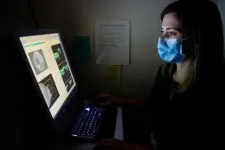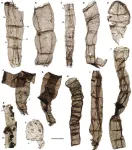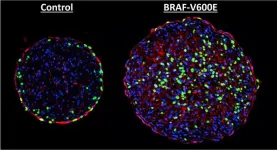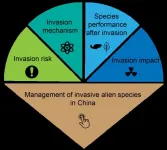(Press-News.org) At least 8% of the human genome is genetic material from viruses. It was considered ‘junk DNA’ until recently, but its role in human development is now known to be essential
Researchers at the Spanish National Cancer Research Centre (CNIO) describe for the first time the role of these viruses in a key process in development, when cells become pluripotent few hours after fertilization
The finding, published in Science Advances, is relevant for regenerative medicine and for the creation of artificial embryos
All animals have evolved thanks to the fact that certain viruses infected primitive organisms hundreds of millions of years ago. Viral genetic material was integrated into the genome of the first multi-cellular beings and is still in our DNA today. Researchers from the CNIO (Spanish National Cancer Research Centre) describe now in the journal Science Advances for the first time the role played by these viruses in a process that is absolutely vital for our development, and which occurs a few hours after fertilisation: the transition to pluripotency, when the oocyte goes from having two to four cells.
Before this step, each of the two cells of the embryo is totipotent, i.e. it may develop inside an independent organism; the four cells of the next stage are not totipotent but are pluripotent, because they can differentiate into cells of any specialised tissue of the body.
For Sergio de la Rosa and Nabil Djouder, first author and senior author respectively, the finding is relevant for the field of regenerative medicine and for the creation of artificial embryos, as it opens up a new way to generate stable cell lines in the totipotency phases. Djouder leads the Growth Factors, Nutrients and Cancer Group at the CNIO.
We are 8% retrovirus
Genetic material from the now so-called 'endogenous retroviruses' was integrated into the genomes of organisms that may have been drivers of the Cambrian explosion, a period more than 500 million years ago when the world's seas underwent a biodiversity boom. Over the past decade, genetic sequences from these viruses have been found to make up at least 8-10% of the human genome.
“Until recently, these viral remnants were considered to be 'junk DNA', genetic material that was unusable or even harmful," explains De la Rosa. "Intuitively, it was thought that having viruses in the genome could not be good. However, in recent years we are starting to realise that these retroviruses, which have co-evolved with us over millions of years, have important functions, such as regulating other genes. It's an extremely active field of research”.
The transition from totipotency to pluripotency, a question of pace
The research published in Science Advances shows that the MERVL endogenous retrovirus sets the pace in embryo development, especially during the specific step of the transition from totipotency to pluripotency, and explains the mechanism that makes this happen.
"It is a totally new role for endogenous retroviruses," says Djouder. "We discovered a new mechanism that explains how an endogenous retrovirus directly controls pluripotency factors".
This new action mechanism involves URI, a gene that Djouder's group is researching in depth. Years ago, it was discovered that if URI is deleted in laboratory animals, embryos do not even get to develop. De la Rosa wanted to find out why, and which is how its link to the MERVL retrovirus was discovered.
A smooth transition
The findings show that one of the functions of URI is to enable the action of molecules essential for acquiring pluripotency; if URI does not act, neither do the pluripotency factors, and the cell remains in a state of totipotency. It turns out to be an endogenous retrovirus protein, MERVL-gag, which modulates the action of URI.
The researchers found that during the totipotency phase, when there are only two cells in the oocyte, expression of the MERVL-gag viral protein is high; this protein binds to URI and prevents it from acting. However, the levels gradually change, so that the levels of MERVL-gag viral protein go down and URI can enter into action: pluripotency appears.
As De la Rosa explains, "It's a smooth transition. When there is a high expression of viral protein, there are fewer pluripotency factors; as ERV expression decreases, URI stabilises such factors”.
Symbiotic co-evolution
“Our findings reveal symbiotic co-evolution of endogenous retroviruses with their host cells in order to guarantee the smooth and timely progression of early embryonic development," explain the authors in Science Advances.
In other words, the three-way relationship between the viral protein, URI and pluripotency factors is finely modulated, "to allow sufficient time for the embryo to adjust and coordinate the smooth transition from totipotency to pluripotency and cell lineage specification during embryonic development," concludes Djouder.
END
LOS ANGELES — Researchers at City of Hope, one of the largest cancer research and treatment organizations in the United States, and Translational Genomics Research Institute (TGen), a precision medicine research organization that is part of City of Hope, have developed and tested an innovative machine-learning approach that could one day enable the earlier detection of cancer in patients by using smaller blood draws. The study was published today in the journal Science Translational Medicine.
“A huge body of evidence shows that cancer caught at later stages kills people. This new technology gets us closer to a world ...
Francis Crick Institute press release
Under strict embargo: 19:00hrs GMT 24 January 2024
Peer reviewed
Experimental study
Animals
Gene behind heart defects in Down syndrome identified
Researchers at the Francis Crick Institute and UCL have identified a gene that causes heart defects in Down syndrome, a condition that results from an additional copy of chromosome 21.
Reducing the overactivity of this gene partially reversed these defects in mice, setting the scene for potential future therapies for heart conditions in people with Down syndrome.
Down syndrome ...
Genova (Italy), 24 January 2024 - Over the past four years, the research team at the Artificial and Mechanical Intelligence (AMI) lab at the Istituto Italiano di Tecnologia (IIT-Italian Institute of Technology) in Genova (Italy) has developed advanced avatar technologies, known as the iCub3 system, in continuous testing with real-world scenarios. The system was utilized to enable a human operator to remotely visit locations 300 km away, to entertain the public at events and television appearances, and ...
Mass Eye and Ear physician-researchers show that retinal imaging can help predict a person’s risk of developing ocular, neuropsychiatric, cardiac, metabolic, and pulmonary diseases.
The team also identified genetic loci associated with retinal thinning, which could help develop personalized treatment plans and future therapies for eye diseases such as glaucoma and macular degeneration.
The retina is said to provide a window into a person’s systemic health. In a new study published January 24th in Science Translational Medicine, physician-researchers from Mass ...
In a study published in Science Advances on Jan. 24, researchers led by Prof. ZHU Maoyan from the Nanjing Institute of Geology and Palaeontology of the Chinese Academy of Sciences reported their recent discovery of 1.63-billion-year-old multicellular fossils from North China.
These exquisitely preserved microfossils are currently considered the oldest record of multicellular eukaryotes. This study is another breakthrough after the researchers’ earlier discovery of decimeter-sized eukaryotic fossils in the Yanshan area ...
DURHAM, N.C. – Biomedical engineers at Duke University have demonstrated that one of the most dangerous mutations found in skin cancers might moonlight as a pathway to mending a broken heart.
The genetic mutation in the protein BRAF, a part of the MAPK signaling pathway that can promote cell division, is one of the most common and most aggressive found in melanoma patients. In a new study, researchers show that introducing this mutation to rat heart tissue grown in a laboratory can induce growth.
Repairing ...
This month, the Ecological Society of America spotlights the challenge posed by invasive alien species in China with the release of a Special Feature, “Management of Biological Invasions in China,” in the latest issue of its journal Ecological Applications.
Accelerating rates of biological invasion have led to growing concerns about the destructive impacts of invasive alien species, or IAS, on the environment and human societies. This is especially true in China, which has witnessed a surge in ...
Researchers with the Department of Energy’s SLAC National Accelerator Laboratory, Stanford University and the DOE's Lawrence Berkeley National Laboratory (LBNL) grew a twisted multilayer crystal structure for the first time and measured the structure’s key properties. The twisted structure could help researchers develop next-generation materials for solar cells, quantum computers, lasers and other devices.
“This structure is something that we have not seen before – it was a huge surprise to me,” said Yi Cui, a professor at Stanford and SLAC and paper co-author. “A new quantum electronic property could appear ...
Since the creation of the National Flood Insurance Program (NFIP) in 1968, the U.S. government has paid over $51 billion to cover flood losses. Almost half of these payouts went to just 25 counties, among the fastest-growing counties by population. A new paper published in the Journal of the Association of Environmental and Resource Economists examines whether insuring people against potential flood losses contributes directly to population growth in flood-prone areas. In “Does the National Flood Insurance Program Drive Migration ...
Fresh research into the physics of vibrating nanobubbles reveals that they do not heat up as much as previously thought.
Vibrating nanobubbles have surprising uses as ultrasound contrast agents in cancer diagnosis. They can also be forced to collapse - destroying nearby microscopic contaminants - for waste-water treatment and surface cleaning of delicate microfluidic devices.
The stiffness of a nanobubble as it vibrates is strongly related to their internal temperature, and being able to understand ...








